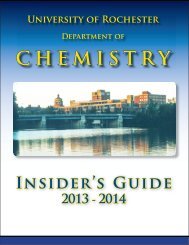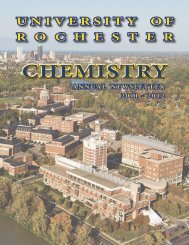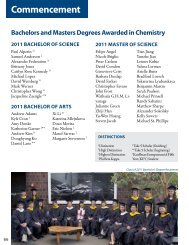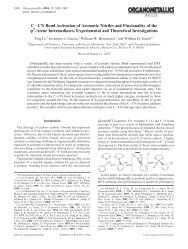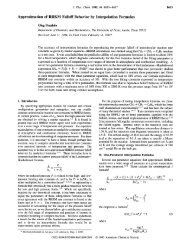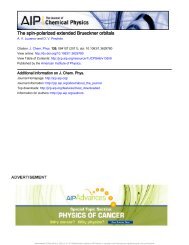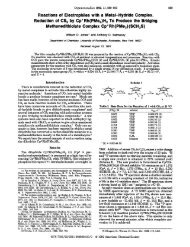Organometallics, 1999, 18, 1754-1760 - Chemistry - University of ...
Organometallics, 1999, 18, 1754-1760 - Chemistry - University of ...
Organometallics, 1999, 18, 1754-1760 - Chemistry - University of ...
Create successful ePaper yourself
Turn your PDF publications into a flip-book with our unique Google optimized e-Paper software.
C-H Activation and Ligand Exchange <strong>of</strong> CpRe(PPh 3 ) 2 H 2 <strong>Organometallics</strong>, Vol. <strong>18</strong>, No. 9, <strong>1999</strong> 1757<br />
Scheme 2<br />
Figure 6. Photochemical exchange <strong>of</strong> PPh 3 -d 15 into 1.<br />
support an associative mechanism for phosphine exchange<br />
with the photochemically formed intermediate<br />
D. An alternative explanation for saturation behavior,<br />
namely that the rate is being limited by the photon flux<br />
(i.e., Φ substitution ≈ 1), is unlikely in that this would<br />
require that the excited state be sufficiently long-lived<br />
to undergo bimolecular reaction with PMe 3 . This possibility<br />
can also be discounted, as these substitution<br />
reactions (qualitatively) have quantum yields that are<br />
substantially less than 1.<br />
Comparison <strong>of</strong> the Rates <strong>of</strong> H/D Exchange and<br />
Phosphine Exchange. Since both ligand exchange and<br />
H/D exchange occur via associative mechanisms, the<br />
relative rates <strong>of</strong> these two reactions can be compared if<br />
the substrate concentrations are known. Two NMR<br />
samples <strong>of</strong> 1 in C 6 D 6 (5.14 × 10 -3 M) were prepared.<br />
To the first sample was added excess PPh 3 -d 15 (0.224<br />
M), and to the second sample was added excess n-<br />
pentane (0.88 M). 9 The two samples were irradiated<br />
through a 345 nm filter, and a merry-go-round apparatus<br />
was used to ensure that both samples received<br />
the same number <strong>of</strong> photons. The phosphine exchange<br />
reaction was monitored by integrating the ortho resonances<br />
<strong>of</strong> bound and free PPh 3 -d 0 (by 1 H NMR spectroscopy).<br />
The appearance <strong>of</strong> free PPh 3 -d 0 is exponential<br />
(Figure 6), and fitting to eq 5 gives k obsd ) [1.60(8)] ×<br />
[PPh 3 -d 0 ] ) 2[1] 0 (1 - e -k obst ) (5)<br />
10 -5 s -1 . The H/D exchange catalysis was followed by<br />
monitoring the ratio <strong>of</strong> the internal standard c-C 6 D 12<br />
to n-pentane-d by 2 H NMR. The number <strong>of</strong> turnovers<br />
was then calculated as shown in eq 6. A plot <strong>of</strong> turnover<br />
no. <strong>of</strong> turnovers ) 12( area(C 5 H 11 D)<br />
area(c-C 6 D 12 ))( mol <strong>of</strong> c-C 6 D 12<br />
mol <strong>of</strong> Re )<br />
(6)<br />
number vs time is linear for ∼3 h (25 turnovers), after<br />
which time the catalyst decomposition begins to inhibit<br />
the reaction. From the slope <strong>of</strong> this line, k obsd ) [2.1(4)]<br />
× 10 -3 s -1 for H/D exchange. After correcting the<br />
observed first-order rates <strong>of</strong> H/D exchange and phosphine<br />
exchange for the substrate concentrations, we<br />
found that n-pentane-d is formed at a rate <strong>of</strong> ∼37 times<br />
faster than the rate at which phosphine exchange takes<br />
place.<br />
(9) Trimethylphosphine was not used for this study in order to<br />
eliminate any effects that changes in the UV-vis spectra <strong>of</strong> the<br />
substituted complexes (A and/or ɛ) might introduce into the kinetics<br />
<strong>of</strong> the reaction mechanism due to changes in the amount <strong>of</strong> light<br />
absorbed during the reaction. See: Drolet, D. P.; Lees, A. J. J. Am.<br />
Chem. Soc. 1992, 114, 4<strong>18</strong>6-4194.<br />
Reaction <strong>of</strong> CpReH 2 (PPh 3 ) 2 with D 2 . To test for<br />
the photodissociation <strong>of</strong> H 2 from 1, a sample <strong>of</strong> 1 in C 6 D 6<br />
(5.14 × 10 -3 M) was placed under an atmosphere <strong>of</strong> D 2<br />
and the sample irradiated through a 345 nm filter. If<br />
H 2 dissociation were occurring, then one would expect<br />
to see the rapid formation <strong>of</strong> CpReD 2 (PPh 3 ) 2 and free<br />
H 2 . The reaction was followed by 1 H NMR spectroscopy,<br />
which showed the slow formation <strong>of</strong> CpReD n H 4-n (PPh 3 ),<br />
where integration indicates n ) 2. The hydride resonance<br />
<strong>of</strong> 1 remains sharp throughout the reaction and<br />
does not show a decrease in intensity relative to the<br />
phosphine or Cp resonances which would be expected<br />
for the direct formation <strong>of</strong> CpReD 2 (PPh 3 ) 2 . It therefore<br />
seems reasonable that 1 does not lose H 2 upon photolysis.<br />
Preparation and Reactivity <strong>of</strong> CpReHD(PPh 3 ) 2<br />
(2). The reaction <strong>of</strong> ReD 7 (PPh 3 ) 2 with excess CpH at 60<br />
°C results in the formation <strong>of</strong> CpReHD(PPh 3 ) 2 , as shown<br />
in Scheme 2. 7 The 1 H NMR spectrum <strong>of</strong> 2 is essentially<br />
identical with that <strong>of</strong> 1, except that the hydride resonance<br />
integrates as one hydride instead <strong>of</strong> two. The<br />
hydride-coupled 31 P NMR spectrum <strong>of</strong> 2 shows a broad<br />
doublet, also indicating the presence <strong>of</strong> only one metal<br />
hydride. The photochemistry <strong>of</strong> 2 was examined to see<br />
if both the hydride and the deuteride ligands would be<br />
preserved during catalytic H/D exchange, analogous to<br />
what was seen for 1.<br />
A sample <strong>of</strong> 2 in C 6 D 6 (5.14 × 10 -3 M) was prepared<br />
with n-pentane (0.05 mL, 10% v/v) added as the substrate,<br />
and the sample was then irradiated through a<br />
345 nm filter. Surprisingly, in addition to H/D exchange<br />
catalysis as observed for 1, the deuteride ligand <strong>of</strong> 2 was<br />
observed to diminish with time (over 100 h), as evidenced<br />
by an increase in the M-H resonance in the 1 H<br />
NMR spectrum. A similar experiment in C 6 H 6 solvent<br />
showed the loss <strong>of</strong> the Re-D resonance by 2 H NMR<br />
spectroscopy. Similar observations <strong>of</strong> the loss <strong>of</strong> deuteride<br />
ligand in 2 were seen upon irradiation in neat<br />
C 6 D 6 , methylcyclohexane-d 14 , n-pentane, or THF. As<br />
mentioned earlier, irradiation <strong>of</strong> 1 in C 6 D 6 or methylcyclohexane-d<br />
14 under identical conditions did not result<br />
in the formation <strong>of</strong> 2, nor was 2 formed during any <strong>of</strong><br />
the catalytic H/D exchange reactions.<br />
The observed incorporation <strong>of</strong> hydrogen into the<br />
deuteride resonance <strong>of</strong> 2 during photolysis is in apparent<br />
contrast with the observation that 1 never exhibits<br />
deuterium exchange into its hydride resonance during<br />
H/D exchange between solvents. These two observations<br />
can be accommodated, however, if the pathway that is




